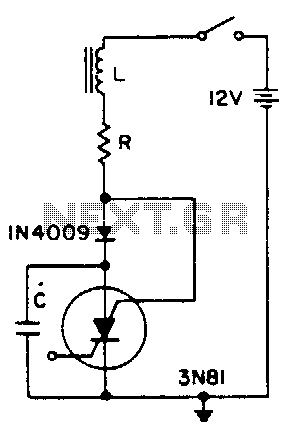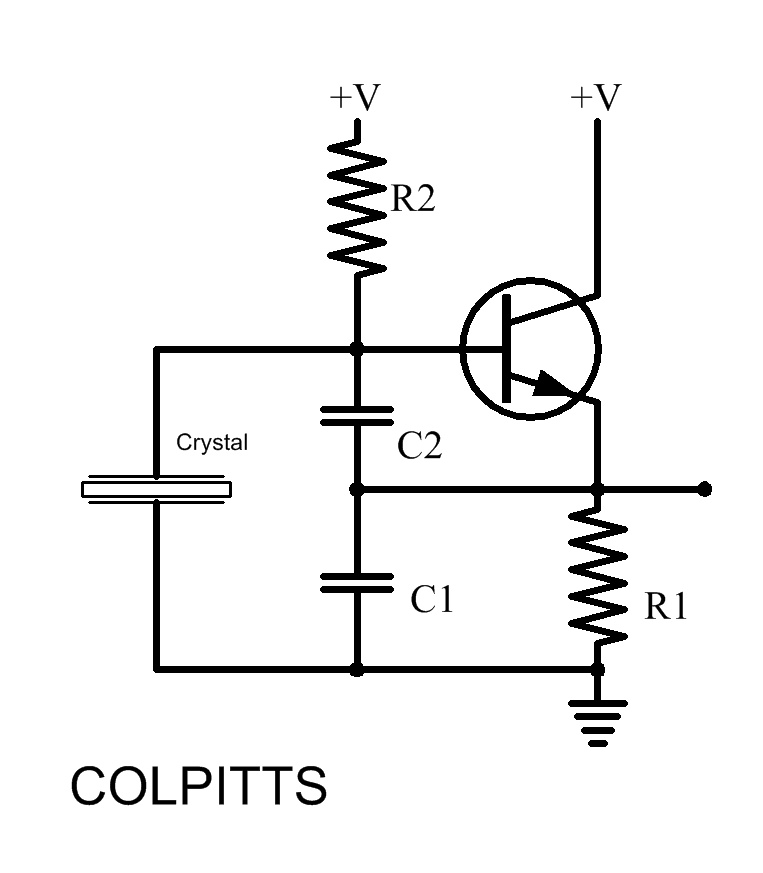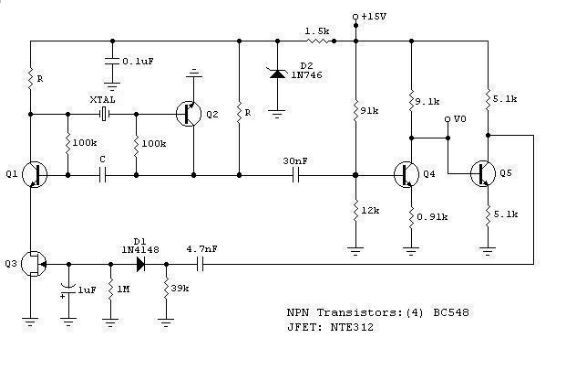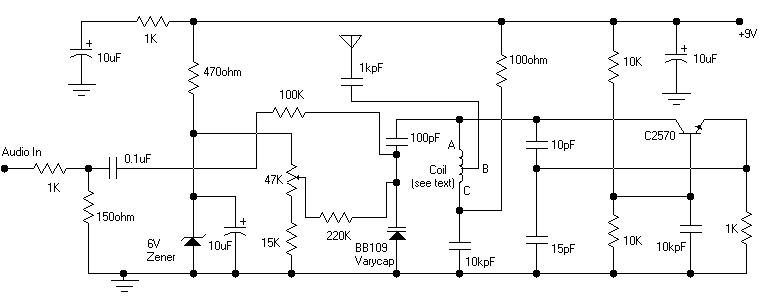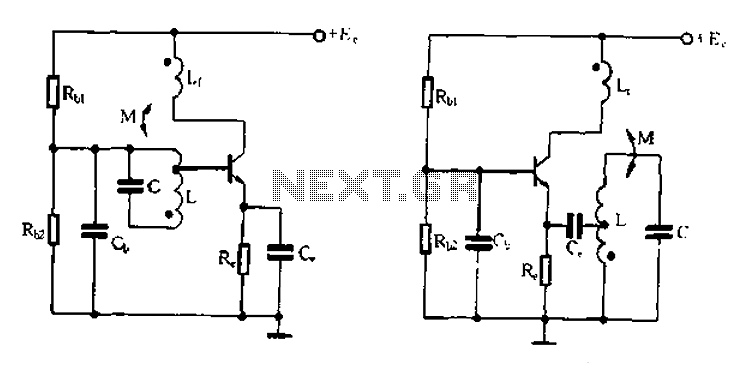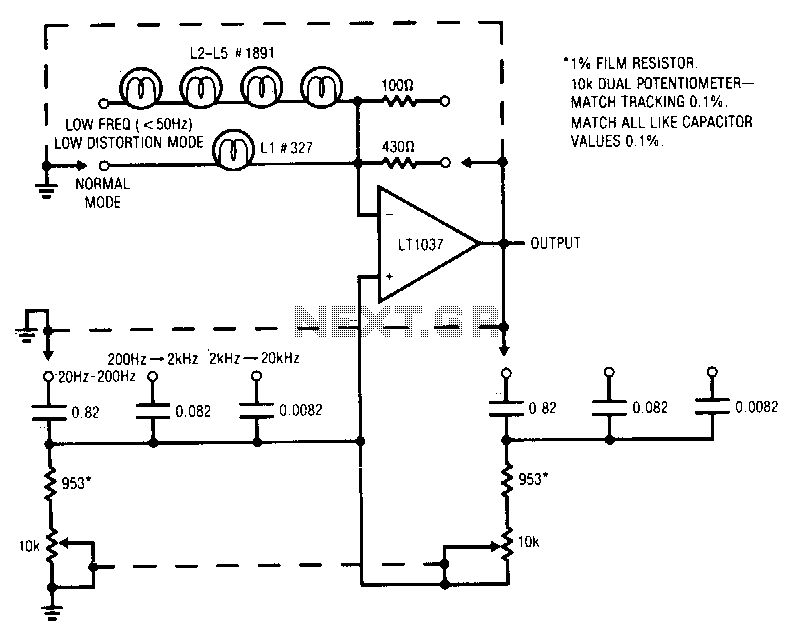
The Hartley Oscillator
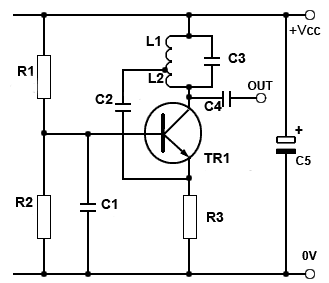
The Hartley Oscillator is a valuable circuit for generating high-quality sine wave signals in the RF range (30 kHz to 30 MHz). However, at the upper limits of this range and beyond, the Colpitts oscillator is typically favored. Both oscillators utilize an LC tuned (tank) circuit to regulate the oscillator frequency. The Hartley design is characterized by its use of a tapped inductor (L1 and L2). The frequency-determining resonant tuned circuit is formed by L1/L2 and C3, which serves as the load impedance for the amplifier. This configuration allows the amplifier to achieve high gain only at the resonant frequency. This specific version of the Hartley circuit employs a common base amplifier, with the base of TR1 connected directly to 0V (for AC signals) through C1. In this configuration, the output voltage waveform at the collector and the input signal at the emitter are in phase. This phase alignment ensures that the feedback from the tuned circuit collector load to the emitter via capacitor C2 provides the necessary positive feedback. C2 also creates a long time constant with the emitter resistor R3, establishing an average DC voltage level proportional to the feedback signal's amplitude at TR1's emitter. This voltage is used to automatically regulate the amplifier's gain to achieve a closed-loop gain of 1. The emitter resistor R3 is not decoupled since the emitter terminal serves as the amplifier input. The base is grounded through C1, which exhibits very low reactance at the oscillator frequency. The LC circuit controlling the oscillation frequency is often referred to as the "TANK CIRCUIT" due to the circulating currents being significantly higher than the supplying current (e.g., pulses of collector current from the amplifier). Its operation is analogous to a water tank that provides a continuous flow from an intermittently flowing external source. The tank circuit contains substantial circulating currents, replenished regularly by smaller amounts of current from the amplifier. Since most current circulates within the resonant tank circuit rather than through the amplifier section, LC oscillators typically produce sine waves with minimal distortion from the amplifier. Additionally, the tank circuit ensures the correct amount of positive feedback required to sustain oscillation. This is accomplished by dividing the inductive branch into two sections with different values, allowing the inductor to function similarly to an autotransformer, with the winding ratio determining the feedback signal's magnitude to the amplifier's input. In the configuration, the top of L1 is connected to +Vcc, effectively grounding it for AC signals through the low impedance of C5. Consequently, waveforms across L1 and the entire circuit are in phase. With a common base amplifier in use, the collector and emitter signals are also in phase, confirming that the tank circuit provides positive feedback. Other Hartley designs, such as those using common emitter amplifiers, utilize similar tank circuits but with different connections to ensure that the feedback signal remains in phase with the input signal, thereby maintaining the necessary positive feedback. It is common in LC sine wave oscillators to implement automatic class C biasing. In class C, the bias voltage (the base voltage of the transistor) is more negative than the emitter voltage, resulting in a negative Vbe and positioning the average (center) voltage of the input wave on the negative portion of the Vbe characteristic curve.
The Hartley oscillator circuit consists of several key components: a tapped inductor, a capacitor, and a transistor configured as a common base amplifier. The tapped inductor, comprising L1 and L2, is crucial for determining the frequency of oscillation. The inductive portion is connected to the collector of the transistor, while the capacitor C3 is connected to ground. This configuration forms a resonant tank circuit, which is responsible for generating the oscillation frequency.
The operation of the Hartley oscillator begins with the initial conditions set by the circuit components. When power is applied, the transistor begins to conduct, and the tank circuit starts oscillating at its resonant frequency. The feedback mechanism is critical for sustaining oscillation; the voltage from the collector is fed back to the emitter through C2, ensuring that the amplifier's output supports the oscillation.
The phase relationship between the output and input signals is essential for maintaining stable oscillations. The common base configuration allows for a high-frequency response while ensuring that the output and input remain in phase. The automatic gain control provided by the feedback loop via R3 and C2 stabilizes the amplitude of the oscillation, preventing distortion and maintaining a clean sine wave output.
In summary, the Hartley oscillator is a widely used circuit for producing sine wave signals in the RF range, characterized by its unique use of a tapped inductor and a common base amplifier configuration. Its ability to generate low-distortion sine waves makes it suitable for various applications in communication systems and signal processing.The Hartley Oscillator is a particularly useful circuit for producing good quality sine wave signals in the RF range, (30kHz to 30MHz) although at the higher limits of this range and above, The Colpitts oscillator is usually preferred. Although both these oscillators oscillator use an LC tuned (tank) circuit to control the oscillator frequency, Th
e Hartley design can be recognised by its use of a tapped inductor (L1 and L2 in Fig. 2. 1. 1). Fig. 2. 1. 1 shows a typical Hartley oscillator. The frequency determining resonant tuned circuit is formed by L1/L2 and C3 and is used as the load impedance of the amplifier. This gives the amplifier a high gain only at the resonant frequency (Method 2 in Introduction to Oscillators).
This particular version of the Hartley circuit uses a common base amplifier, the base of TR1 being connected directly to 0V (as far as AC the signal is concerned) by C1. In this mode the output voltage waveform at the collector, and the input signal at the emitter are in phase.
This ensures that the fraction of the output signal fed back from the tuned circuit collector load to the emitter via the capacitor C2 provides the necessary positive feedback. C2 also forms a long time constant with the emitter resistor R3 to provide an average DC voltage level proportional to the amplitude of the feedback signal at the emitter of Tr1.
This is used to automatically control the gain of the amplifier to give the necessary closed loop gain of 1. The emitter resistor R3 is not decoupled because the emitter terminal is used as the amplifier input.
The base being connected to ground via C1, which will have a very low reactance at the oscillator frequency. The LC circuit that controls the frequency of oscillation is often called the "TANK CIRCUIT" because it contains circulating currents much greater than the current supplying it (e.
g. pulses of collector current supplied by the amplifier). Its operation is supposed to be rather like a water tank or cistern that can supply a continuous flow of water from an intermittently flowing external supply. The tank circuit in the oscillator contains high values of circulating current topped up regularly by smaller amounts of current from the amplifier.
Because most of the current flowing in the oscillator is flowing just around the resonant tank circuit rather than though the amplifier section of the oscillator, LC oscillators generally produce a sine wave with very little amplifier sourced distortion. Another feature of the tank circuit is to provide the correct amount of positive feedback to keep the oscillator running.
This is done by dividing the inductive branch of the circuit into two sections, each having a different value, the inductor therefore works in a similar manner to an autotransformer, the ratio of the two windings providing the appropriate amount of signal to be fed back to the input of the amplifier. Because in Fig. 2. 1. 2 (and Fig. 2. 1. 1) the top of L1 is connected to +Vcc, it is, as far as AC signals are concerned, connected to ground via the very low impedance of C5.
Therefore waveform X across L1, and waveform Y across the whole circuit are in phase. As a common base amplifier is being used, the collector and emitter signals are also in phase, and the tank circuit is therefore providing positive feedback. In other Hartley designs, using common emitter amplifiers for example, similar tank circuits are used but with different connections, so that the feedback signal is always in phase with the input signal, therefore providing the necessary positive feedback.
It is common in LC sine wave oscillators to use automatic class C bias. In class C the bias voltage, that is the base voltage of the transistor is more negative than the emitter voltage, making Vbe negative so that the average (centre) voltage of the input wave is located on the negative portion of the Vbe axis of the characteristic curve show 🔗 External reference
The Hartley oscillator circuit consists of several key components: a tapped inductor, a capacitor, and a transistor configured as a common base amplifier. The tapped inductor, comprising L1 and L2, is crucial for determining the frequency of oscillation. The inductive portion is connected to the collector of the transistor, while the capacitor C3 is connected to ground. This configuration forms a resonant tank circuit, which is responsible for generating the oscillation frequency.
The operation of the Hartley oscillator begins with the initial conditions set by the circuit components. When power is applied, the transistor begins to conduct, and the tank circuit starts oscillating at its resonant frequency. The feedback mechanism is critical for sustaining oscillation; the voltage from the collector is fed back to the emitter through C2, ensuring that the amplifier's output supports the oscillation.
The phase relationship between the output and input signals is essential for maintaining stable oscillations. The common base configuration allows for a high-frequency response while ensuring that the output and input remain in phase. The automatic gain control provided by the feedback loop via R3 and C2 stabilizes the amplitude of the oscillation, preventing distortion and maintaining a clean sine wave output.
In summary, the Hartley oscillator is a widely used circuit for producing sine wave signals in the RF range, characterized by its unique use of a tapped inductor and a common base amplifier configuration. Its ability to generate low-distortion sine waves makes it suitable for various applications in communication systems and signal processing.The Hartley Oscillator is a particularly useful circuit for producing good quality sine wave signals in the RF range, (30kHz to 30MHz) although at the higher limits of this range and above, The Colpitts oscillator is usually preferred. Although both these oscillators oscillator use an LC tuned (tank) circuit to control the oscillator frequency, Th
e Hartley design can be recognised by its use of a tapped inductor (L1 and L2 in Fig. 2. 1. 1). Fig. 2. 1. 1 shows a typical Hartley oscillator. The frequency determining resonant tuned circuit is formed by L1/L2 and C3 and is used as the load impedance of the amplifier. This gives the amplifier a high gain only at the resonant frequency (Method 2 in Introduction to Oscillators).
This particular version of the Hartley circuit uses a common base amplifier, the base of TR1 being connected directly to 0V (as far as AC the signal is concerned) by C1. In this mode the output voltage waveform at the collector, and the input signal at the emitter are in phase.
This ensures that the fraction of the output signal fed back from the tuned circuit collector load to the emitter via the capacitor C2 provides the necessary positive feedback. C2 also forms a long time constant with the emitter resistor R3 to provide an average DC voltage level proportional to the amplitude of the feedback signal at the emitter of Tr1.
This is used to automatically control the gain of the amplifier to give the necessary closed loop gain of 1. The emitter resistor R3 is not decoupled because the emitter terminal is used as the amplifier input.
The base being connected to ground via C1, which will have a very low reactance at the oscillator frequency. The LC circuit that controls the frequency of oscillation is often called the "TANK CIRCUIT" because it contains circulating currents much greater than the current supplying it (e.
g. pulses of collector current supplied by the amplifier). Its operation is supposed to be rather like a water tank or cistern that can supply a continuous flow of water from an intermittently flowing external supply. The tank circuit in the oscillator contains high values of circulating current topped up regularly by smaller amounts of current from the amplifier.
Because most of the current flowing in the oscillator is flowing just around the resonant tank circuit rather than though the amplifier section of the oscillator, LC oscillators generally produce a sine wave with very little amplifier sourced distortion. Another feature of the tank circuit is to provide the correct amount of positive feedback to keep the oscillator running.
This is done by dividing the inductive branch of the circuit into two sections, each having a different value, the inductor therefore works in a similar manner to an autotransformer, the ratio of the two windings providing the appropriate amount of signal to be fed back to the input of the amplifier. Because in Fig. 2. 1. 2 (and Fig. 2. 1. 1) the top of L1 is connected to +Vcc, it is, as far as AC signals are concerned, connected to ground via the very low impedance of C5.
Therefore waveform X across L1, and waveform Y across the whole circuit are in phase. As a common base amplifier is being used, the collector and emitter signals are also in phase, and the tank circuit is therefore providing positive feedback. In other Hartley designs, using common emitter amplifiers for example, similar tank circuits are used but with different connections, so that the feedback signal is always in phase with the input signal, therefore providing the necessary positive feedback.
It is common in LC sine wave oscillators to use automatic class C bias. In class C the bias voltage, that is the base voltage of the transistor is more negative than the emitter voltage, making Vbe negative so that the average (centre) voltage of the input wave is located on the negative portion of the Vbe axis of the characteristic curve show 🔗 External reference
